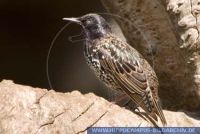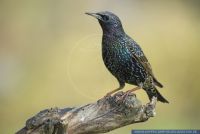Sturnus vulgaris
European Starling
Exif Keywords: Natur, Nature, Animals, Tiere, Fauna, Voegel, Vogel, Bird, Fliegen, Fly
Exif ImageDescription: Sturnus vulgaris, Star, European Starling
The European Starling or Common Starling, Sturnus vulgaris, is a passerine bird in the family Sturnidae. This starling is native to most of temperate Eurasia except East Asia, but has been introduced to South Africa, North America, Australia and New Zealand. It is resident in southern and western Europe and southern Eurasia, but northern populations migrate in winter to these regions, and also further south to areas where it does not breed in Iberia and north Africa.The 19-22 cm long European Starling is among the most familiar of birds in temperate regions, with its shiny black plumage spangled with white. Confusion is only likely in Iberia in winter, when it has to be distinguished from the closely related Spotless Starling, which, as its name implies, has less spotting on its plumage. Adult male European Blackbirds can be easily distinguished by more slender body shape, longer tail, and behavior: they hop instead of walking and do not probe for food with open bills. Adult male European Starlings are less spotted below than adult females. Juveniles are dull brown, and by their first winter resemble adults but are browner especially on the head. Starlings walk rather than hop. Their flight is quite strong and direct; they look triangular-winged and short-tailed in flight. In most of Europe, only the rarer and much paler Bohemian Waxwing shares this flight profile. This is a noisy bird uttering a wide variety of mechanical-sounding and melodic sounds, including a distinctive "wolf whistle." Starlings are also noted as mimics, like many of its family. In captivity, Starlings will learn to imitate all types of sounds and speech earning them the nickname "Poor-man's Myna". Source:Wikipedia
Viewed 6453 times















